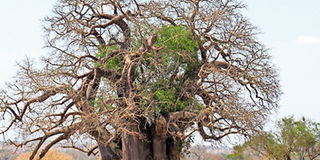The many things you can get from a baobab tree

Baobab tree. The tree has an extensive root system with high water-holding capacity and its tender roots, tubers, twigs, fruit, seeds, leaves and flowers are all edible and common ingredients in many food dishes. FILE PHOTO | NMG
What you need to know:
- The fruit is an excellent source of vitamin C. It contains the vitamin 10 times that of an orange, while leaves are high in calcium, iron, potassium, magnesium, manganese, molybdenum, phosphorus, zinc and pro-vitamin A.
- The dry pulp is either eaten fresh, mixed with milk as a drink or used in cooking as a seasoning component and appetiser. Besides food uses, the fruit pods are burnt to obtain ash for soap making.
- The hard fruit shells are used as pots for beverages and food. The wood is a poor source of fuel; the fruit shells are used instead.
- Optional ingredients that are used to improve flavour and add fragrance are chilli or ground black pepper, ginger, ground nutmeg, ground cardamom and rose water or other types of essence.
African baobab (Adansonia digitata L.) is a tree that lives for many years and has various uses.
Some of the trees are thought to be over 1,000 years old. They are neither grown agronomically nor properly domesticated yet they provide food, shelter and clothing as well as material for hunting and fishing.
Every part of the baobab tree is useful. The tree has an extensive root system and high waterholding capacity. It has tender roots, tubers, twigs, fruit, seeds, leaves and flowers all that are edible and are common ingredients in many food dishes.
The fruit is an excellent source of vitamin C. It contains the vitamin 10 times that of an orange, while leaves are high in calcium, iron, potassium, magnesium, manganese, molybdenum, phosphorus, zinc and pro-vitamin A.
The leaves are a major food item in some parts of this continent. They are usually boiled with tubers and mashed, used as fresh vegetables, for soup and sauces and added to meat and fish stews.
The fruit pulp is one of the most important parts of the tree. It is used to make a refreshing drink with fermented flavour. It is also added to aid fermentation of sugar cane for beer making.
The dry pulp is either eaten fresh, mixed with milk as a drink or used in cooking as a seasoning component and appetiser. Besides food uses, the fruit pods are burnt to obtain ash for soap making.
The seeds are used as a thickener in soups or a flavouring agent when fermented for roasted food dishes. They can also be roasted and used as a substitute for coffee.
OTHER USES
Ropes, basket nets, snares and fishing lines are made from the fibre found in the inner bark of the tree. The roots and green bark are used to make dyes.
The hard fruit shells are used as pots for beverages and food. The wood is a poor source of fuel; the fruit shells are used instead.
Baobab candy is commonly made and marketed at the Coast. The candy is made by coating the baobab fruit seeds with a coloured, fragrant sugar layer.
The resulting product is locally known as mabuyu or ubuyu. Red food colour is commonly used, however, this is optional as other colours and various flavours can be used.
The main ingredients are the baobab seeds and baobab powder. For the syrup that is used to coat the seeds, you need water, sugar, and food colour.
Optional ingredients that are used to improve flavour and add fragrance are chilli or ground black pepper, ginger, ground nutmeg, ground cardamom and rose water or other types of essence.
Baobab is a dry arid land tree. Value addition to the seeds and other extracts of this tree can be a source of livelihoods to people living in these areas.
The fruit is highly nutritious since it is very rich in Vitamin C, therefore, a source of good human health. This vitamin is an essential nutrient involved in the repair of tissue and enzymatic production of certain neurotransmitters. It is a strong antioxidant.
The writer works in the Department of Human Nutrition, Egerton University.




